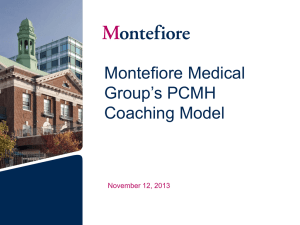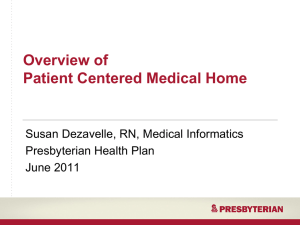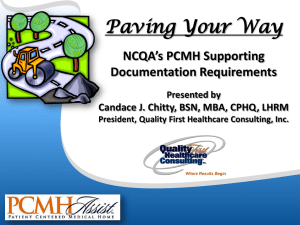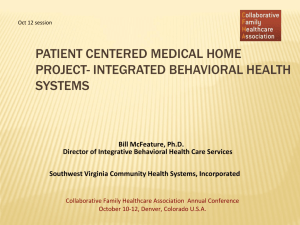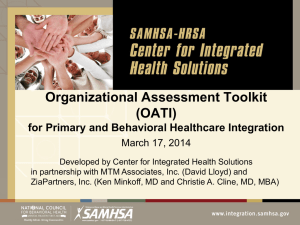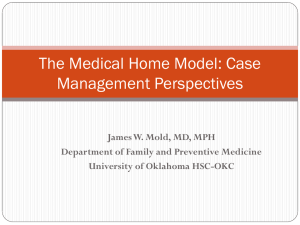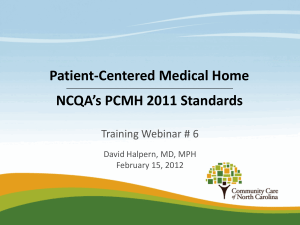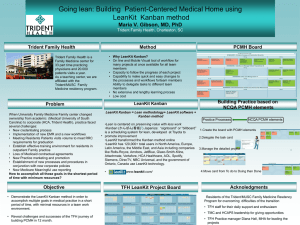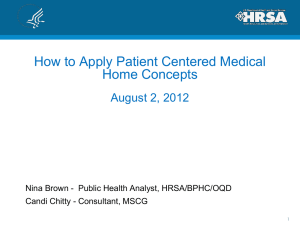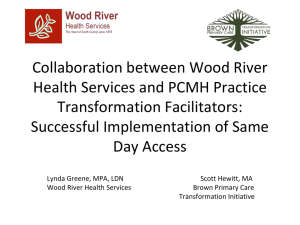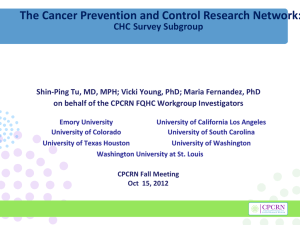presentation ( format)
advertisement
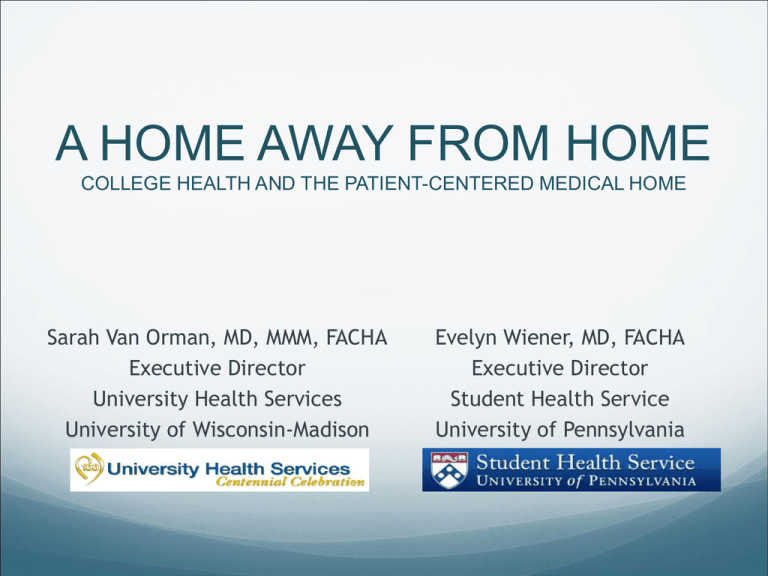
A HOME AWAY FROM HOME COLLEGE HEALTH AND THE PATIENT-CENTERED MEDICAL HOME Sarah Van Orman, MD, MMM, FACHA Executive Director University Health Services University of Wisconsin-Madison Evelyn Wiener, MD, FACHA Executive Director Student Health Service University of Pennsylvania SESSION OBJECTIVES Describe the development of the Medical Home model. Explain the key elements of a Medical Home. Discuss challenges and advantages of implementing Medical Home in the college health setting. 2 MEDICAL HOME The Medical Home, also known as the Patient Centered Medical Home (PCMH), is defined as "an approach to providing comprehensive primary care ... that facilitates partnerships between individual patients, and their personal providers, and when appropriate, the patient’s family”. The provision of medical homes may allow better access to health care, increase satisfaction with care, and improve health. Wikipedia 3 American Academy of Pediatrics 1967 Standards of Child Health Care Proposed system to coordinate care of children with special health needs Emphasis on information with a single central repository of a child’s medical records where information from all sources would be collected 1992 Policy statement defining Medical Home “Accessible, continuous, comprehensive, family centered, coordinated and compassionate” pediatric care. 4 Value Based Health Care Reform Principles-Payment aligned with outcomes • Access • Care Coordination • Transfer and exchange of Information • Accountability • Consumerism • Health IT as an enabler, not a driver 5 Legislation • Patient Protection and Affordable Care Act • Calls for investments in patient-centered care. • PCMH is an important part of this care; necessary, but not sufficient. • Accountable Care Organizations create the neighborhood; PCMH are the home. • American Reinvestment and Recovery Act • HITECH-“Medicare and Medicaid EHR Incentive Programs will provide incentive payments …(to) adopt, implement, upgrade or demonstrate meaningful use of certified EHR technology.” 6 Accountable Care Organizations • • Change in payment system for Medicare beneficiaries • • Central role of primary care with PCMH Requirements: Holds organization responsible for controlling cost, improving quality, and the experience for a population of patients with performance risk-based reimbursement • • • • • • • • Information about patient Population management ability Resources for patient self-management Culture of teamwork Coordinated relationships with other providers Ability to report and measure quality of care Ability to manage financial risk Commitment and systems to improve performance Center for Healthcare Quality and Payment Reform 7 Joint Principles of the Patient-Centered Medical Home • Joint Principles • • • • Personal physician Physician directed medical practice Whole person orientation Care is coordinated and/or integrated across all elements of the health care system • Quality and safety are hallmarks of the medical home • Additional elements • Enhanced access to care • Payment 8 • 2006: Physician Practice Connections® (PPC) • Recognition of practices using information technology and systematic processes • 2008: Physician Practice Connections–PatientCentered Medical Home (PPC-PCMHTM) • Recognition of primary care practices functioning as patient-centered medical homes • 2011: PCMH 2011 • Emphasis on patient-centeredness and patient experience of care • Reinforces incentives for meaningful use 9 NCQA 2011 • 6 standards, 27 elements, 149 factors • Scored on 0 to 100 point scale • 6 must-pass elements • Three levels of recognition based on scoring • Level 1 Recognition: 35 – 59 points, all 6 must-pass elements • Level 2 Recognition: 60 – 84 points, all 6 must-pass elements • Level 1 Recognition: 85 – 100 points, all 6 must-pass elements 10 NCQA 2011 • PCMH 1: Enhance Access and Continuity (20 points) • • • • • • PCMH 1, Element A: Access During Office Hours PCMH 2: Identify and Manage Patient Populations (16 points) • PCMH 2, Element D: Use Data for Population Management PCMH 3: Plan and Manage Care (17 points) • PCMH 3, Element C: Care Management PCMH 4: Provide Self-Care and Community Support (9 points) • PCMH 4, Element A: Support Self-Care Process PCMH 5: Track and Coordinate Care (18 points) • PCMH 5, Element B: Track Referrals and Follow-Up PCMH 6: Measure and Improve (20 points) • PCMH 6, Element C: Implement Continuous Quality Improvement 11 • First accrediting body to conduct on-site survey for organizations seeking PCMH validation • 2009: Accredited organizations allowed to choose Medical Home chapter as part of survey • 2011: Pilot Medical Home certification (separate from accreditation) • 5 Core Standard Areas • Electronic Data Management as a tool to achieve the standards. 12 AAAHC • Foundation is relationship between patient and Medical Home • Medical Home assessed from perspective of patient • 5 Core Standard Areas • • • • • Relationship Continuity of Care Comprehensiveness of Care Accessibility Quality • Electronic Data Management as a tool to achieve the standards. 13 2011: Primary Care Home Option Available only to accredited ambulatory care organizations No special application requirements Current ambulatory care accreditation ~900 Elements of Performance Primary Care Home option 123 existing EPs Plus 54 new EPs 14 Primary Care Home Option Operational Characteristics Patient-centered care Comprehensive care Coordinated care Superb access to care Systems-based approach to quality and safety 15 JOINT PRINCIPLES AAAHC Personal physician Practice Team Physician or physiciandirected health care team Physician directed medical practice Plan and Manage Care Physician-directed health care team Whole person orientation Provide Self-Care and Community Support Relationship between patient and Medical Home Continuity of Care Designated Primary Care Clinician Patient-centered care Continuity of Care Care is coordinated and/or integrated Track and Coordinate Care Quality and safety Measure and Improve Performance Quality Systems-based approach to quality and safety Enhance Access and Continuity Accessibility Access to care Enhanced access to care Identify and Manage Patient Populations Comprehensiveness of Care Comprehensive Care 16 Young Adult Population CDC: 96% of 18-24-year-olds report being in excellent, very good, or good health; only 4.6% report any limitations. Lowest insurance rate ACHA 10%. High emergency department use. Disease burden: mental health, preventable accidents and injuries. 17 “Bridges to Health” model: Various subpopulations with distinct needs Overall Adult Population Student Population • • • • • • • Healthy Individuals Pregnant mothers and infants Acutely ill individuals Individuals with serious disabilities who are stable Individuals with chronic conditions who have normal functioning Individuals with chronic conditions who have limited reserve and experience exacerbations Frail individuals Milbank Quarterly, Vol. 85, No. 2, 2007 (pp. 185-208) • • • • • • • Healthy Individuals Pregnant mothers and infants Acutely ill individuals Individuals with serious disabilities who are stable Individuals with chronic conditions who have normal functioning Individuals with chronic conditions who have limited reserve and experience exacerbations Frail individuals 18 Student Population Healthy Individuals-may be most challenging Goal is health, not healthcare Highest yield community based strategies Significant cost reductions are far in the future No evidence that care coordination improves quality or utilization and it may increase cost Acutely ill individuals Individuals with chronic conditions with/without normal functioning or serious disabilities who are stable For all, goals of college health programs include academic success. 19 Institute for Healthcare ImprovementsTriple Aim Improve the health of HealthCare the population; Enhance the patient experience of care (including quality, access, and reliability); and Reduce, or at least control, the per capita cost of care. Public Health Social Services 20 Healthy Campus 2010/2020 American College Health Association. Healthy Campus 2010 Manual. Baltimore, MD: February 2006 21 College Health Model Environment Policy Population Education Social Marketing Programs . Public Health Direct care Acute Care Prevention Chronic Care 22 Models Healthcare System Environment Population Direct Care College Healthcare System Environment Population Direct Care 23 College Health Funding Model Student Health Fee Tuition Funds Health Insurance Billing Out of pocket costs 24 Health Fee Funding 80% 75% 69% 70% 60% 57% 50% 42% Total 40% 30% Private 29% Public 24% 20% 10% 0% Yes No 2010 Survey on the Utilization of Student Health Services; David R. McBride, MD, Sarah Van Orman, MD, Chris Wera, CPA, and Victor Leino, PhD 25 Medical Services Utilization National Ambulatory Medical Care Surveys or National Hospital Ambulatory Medical Care Surveys 1997-2004 compared adolescents to young adults Visits per capita 95% CI Men 1.10 1.06-1.15 Women 2.31 2.26-2.35 Male-Preventive 0.11 0.10-0.13 Female-Preventive 0.48 0.46-0.5 Annals of Internal Medicine 151(6) 379-385 26 Visits/Eligible Student Medical 2.5 2.0 2.0 1.7 1.5 1.4 2006 Survey 1.2 2010 Survey 1.0 0.8 0.8 0.5 0.0 25th Median 75th 27 Young Adult Population Need integrated information or patient health record to ensure continuity across health care settings Preventive interventions outside of traditional model • During acute care • Asynchronous and non-face to face Community and population based with support direct service in addition to prevention. College health supplements young adult health care. Ex: 7% of young adults reported receiving mental health services. OR 1.47(1.04-2.08) if in school. (JAH 43(2008) 268-276) 28 PCMH for College Health 29 PCMH for College Students Personal physician ? Physician directed medical practice Staffing models vary per institutional needs Whole person orientation Focus on health promotion and environmental interventions as well as academic mission Care is coordinated and/or integrated Multiple care sites (family, SHS, local community) Supports acute care as primary delivery site Quality and safety Avoid ineffective testing and screening Evidence-based primary prevention Enhanced access Rapid access to care Asynchronous and non-face to face On-line and self-care information Payment Diverse set of programs supported by diverse funding mechanisms 30 CORNELL UNIVERSITY Two campuses: Main campus: Ithaca New York (rural, isolated) Academic medical center with separate administration in New York City (4 hours away) One office location 20,900 students 13,900 undergraduate/7,000 graduate-professional 51% students enrolled in school insurance plan 33% UG, 97% grad, 69% professional Does not provide services to employee Mixed Funding Source Covers medical visits, mental health visits and health promotion Fee for service for lab, radiology, procedures, physical therapy Full pharmacy (participates with pharmacy benefits plans for 80% students) 31 CORNELL UNIVERSITY • Hours • Open 46.5 hours/week during academic year • 8:30 AM to 5:00 PM M-F for comprehensive services • 5:00 PM to 7:00 PM M-Th for mental health walk-in and triage (Fall 2011) • 10:00 AM to 4:00 PM Saturday • After-hours call covered by staff nurses • Electronic Health Record system (Point and Click • Used for growing scope of on-line scheduling and communications 32 CORNELL UNIVERSITY Staffing 6.58 FTE primary care physicians 5.20 FTE primary care advanced practice nurses 9.20 FTE primary care nurses 25.38 FTE CAPS clinicians Utilization 35,540 primary care visits 40 % visits with assigned PCP 21,000 counseling visits 33 CORNELL UNIVERSITY Accredited by AAAHC Exploring recognition through NCQA Working with local physician organization PCMH well aligned with current effort to as as PCP, monitor quality and improve continuity of care Developed self-assessment tool to determine where additional efforts needed Possible need for additional resources to achieve Level 3 recognition Considering AAAHC/PCMH accreditation as alternative to NCQA 34 UNIVERSITY OF ROCHESTER Academic Medical Center Three office locations 8,000 students 5,000 undergraduate/3,000 graduate-professional 3,500 students enrolled in school insurance plan Also serves 3,000 employees (primary care) Dedicated health service fee for students $524 in 2010-2011 Covers primary care, counseling, health promotion 35 UNIVERSITY OF ROCHESTER • Hours • Main office open 72 hours/wk. during academic year • Includes weekend hours (nurse and medical ass’t) • Physician on call for telephone consultation when UHS closed • Electronic Health Record system (PyraMed) • Not used for on-line scheduling or communication 36 UNIVERSITY OF ROCHESTER Staffing 5 primary care physicians (3 fulltime) 5 primary care advanced practice nurses (2 fulltime) 10 FTE primary care nurses 5 psychologists 2 fulltime LCSW counselors Utilization 23,000 medical visits At least 60% visits are with assigned PCP 7,000 counseling visits 37 UNIVERSITY OF ROCHESTER Previous accreditation by Joint Commission First AAAHC accreditation survey this year Implementation of PCMH this year AAAHC survey June 2011 “No risk” PCMH review as part of overall survey Less emphasis on use of EHR to monitor compliance with elements/requirements 38 UNIVERSITY OF ROCHESTER Incremental implementation - invite specific patients to join PCMH program Start with non-student patients Expand to include some students (graduate students with chronic illness) Patient has to select PCMH - may not have another “home” Unclear how to manage students who go home for summer, retirees who go south for winter 39 UNIVERSITY OF GEORGIA New Academic Medical Center started 2010 One location 34,885 students 26,000 undergraduate/8,700 graduate-professional ? students enrolled in school insurance plan Only ancillary services available to employees Dedicated health service fee for students $191 per semester in 2010-2011 Covers primary care, counseling, health promotion 40 UNIVERSITY OF GEORGIA Hours Open 76 hours/week during academic year 8:00 AM – 8:00 PM Monday – Friday 10: AM – 5:00 PM Saturday and Sunday After-hours coverage referred to ER or contact Medical Director or CAPS Director via UGA-Police Electronic Health Record system (Point and Click) Open Communicator for adding health information to record, immunization record review, scheduling 50 % appointments scheduled on-line 41 UNIVERSITY OF GEORGIA Staffing 33 medical clinicians (27.0 FTE) 16 physicians (13.33 FTE) 2 Dentists; 2 Optometrists 5 advanced practice nurses (3.3 FTE) 7 physicians’ assistants (6.76 FTE) 9 nurses (9.0 FTE) 26 CAPS clinicians (20.9 FTE) 3 psychiatrists (1.9 FTE); 1 APRN 13 psychologists (13.0 FTE) 10 other clinical staff (6.0 FTE) Utilization 59,000 direct primary care and women’s health visits 49% with assigned PCP, 83% with PCP team 13,000 counseling visits 42 UNIVERSITY OF GEORGIA Implemented principles of advance access and medical home Fall 2008 All students assigned to PCP and team 49 % students seen by PCP, 83 % seen by team Others seen in Urgent Care, or specialty clinics Sports Medicine, Women’s Clinic “Clinical excellence teams” for selected conditions Accredited by Joint Commission Considering optional accreditation as PCMH by Joint Commission 43 UNIVERSITY OF GEORGIA Current areas of focus PC.10.10.10 The patient has access to the organization 24 hours a day, seven days a week. Note: Access may be provided through a number of methods, including telephone, email, flexible hours, websites, and portals. Provision of 24/7 access to clinician for advice Aug 2011Contracting with GM Southwest to offer 24/7 Nurse and MD advice line Providing patient 24/7 access to prescription refills, lab results, registration and billing information Establishing Health Literacy tools Electronic Prescribing Establishment of operational and clinical benchmarks with other student health centers 44 PCMH in the College Health setting CHALLENGES Preference for access over continuity Instability Insurance Geographic Location Articulation with other medical systems and/or providers Evolving payment structures Ownership and control Resolving disputes about care Is this what healthy people need? 45 PCMH in the College Health setting OPPORTUNITIES Opportunities to ensure patient level preventive services are provided during acute care visits Some with capacity to be PCMH All with capacity to not only address college student population health through public health, health promotion and other environmental interventions, but also to be a model for other healthcare delivery systems 46 Quality Outcomes Financial outcomes impractical except in mental health Patient level outcomes-experience of care and quality measures Population/Environment Based 47 A Home Away from Home Communicate and collaborate with PCMH for students with chronic illness or serve as PCMH Protect and promote health through an environmental and population based approach Current funding model-Fee for service or value-based payment through ACO-like models may not support 48 Acknowledgements Janet Corson-Rikert, MD (Cornell University) Ed Ehlinger, MD (State of Minnesota) Ron Forehand, MD (University of Georgia) Victor Leino, PhD (American College Health Association) Ralph Manchester, MD (University of Rochester) Christopher Payne, PT, MHA (Cornell University) 49
